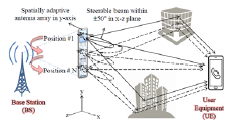Competitive Advantages
- Enhanced wireless channel gain and system capacity
- 7.8 dB improvement in SIR
- Maximized signal power and reduced fading
- Low-cost, compact and efficient devices
Summary
USF scientists propose wireless channel control by means of spatial-ly adaptive antennas where the phase of each multipath compo-nent is affected by the position of the antenna array. The objective, therefore, is to find the best array position that will help attain maximum signal power and reduced fading. Spatial displacement of the antenna array improves system reliability and provides addi-tional degree of freedom. Microfluidically reconfigurable RF devices are employed, which in contrast to a mechanical assembly, require movement of a lower mass, thereby, allowing the feed network to remain stationary. This results in low-cost, compact and efficient devices. The advantages of the proposed system are demonstrated by using a 28 GHz wire-less communication system as a model. A gain of 7.8 dB was noted in the signal-to-interference ratio (SIR) on part of the user, due to the inclusion of the spatial adaptation capability.

Illustrating the Base station (BS) Changes in Position to Maximize Signal Power and Reduce Fading
Desired Partnerships
- License
- Sponsored Research
- Co-Development